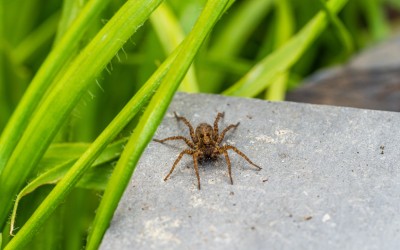You may enjoy the sweets and scares of Halloween, but things get all too real as soon as you see an actual spider in your home. For most the instinct is to grab the nearest and heaviest object and use it to squish the eight-legged invader. The urge will probably be even stronger if it’s a particularly big spider. But what if we told you that stomping that spider without looking may result in a rippling onslaught of baby spiders by the hundreds?
This isn’t the plot of a cheesy horror movie – it’s a very real possibility when dealing with the wolf spider. So how can you identify this particular arachnid, and what can you do to keep it from getting into your home?
Wolf Spider Habits and Appearance
Wolf spiders range in size, from 1.5″ to 4″ depending on the climate they’re found in. Their bodies are made up of two parts, the cephalothorax and the abdomen, along with a set of fang-like mouthparts called the chelicerae. Because of their appearance, they’re often mistaken for other, more dangerous species like the black widow or the brown recluse. Wolf spiders are unique in that unlike these sister spiders, they’re free roaming and don’t make webs.
While being far from the fastest runners in the world, the wolf spider can skitter to capture prey at two feet a second. They eat larger insects like roaches and grasshoppers, and other smaller, less fortunate spiders. And since they don’t have a web, the mother wolf spider chooses instead to carry her young on her back. From eggs in a sac to a cluster of spiderlings, this hardworking single mother keeps her hundreds of children close at all times. So, if you kill or attempt to disturb the mother, these babies will scatter in every direction.
You can avoid turning your home into a daycare of scared spider children. All you need to do is take a few simple precautions.
Getting Spider-Free
Spiders, wolf spiders included, like to hide in a place where they won’t be disturbed. When out in the wild, wolf spiders love to nest under tree roots or in the cover of fallen leaves. If they were to get inside, they’ll prefer to stay amongst the cluttered, quiet corners of the house. That’s why we suggest vacuuming on a regular basis, along with keeping your closets, basement and attic clear of clutter. Doing that will make it so spiders have fewer places to hide and set up shop.
Outside the home, you can create a similar effect by moving piles of firewood and debris away, if they’re against the side of your home. You can also trim shrubs and any tree branches touching the roof. Spiders do not choose to come into your house by chance. If you make it inconvenient for them to get in, they usually won’t. But if all that doesn’t work, you can count on Southern Pest Control to solve your spider problem in no time.
Southern Pest Spider Control
We provide long-term spider control for homes on the Mississippi Gulf Coast. We can send an expert to your home that will find entry points that spiders can take advantage of and seal them up. Once we finish, you’ll be able to enjoy your scares through the safety of a television screen – and have a happy, and spider-free, Halloween. To get started, contact us today!

